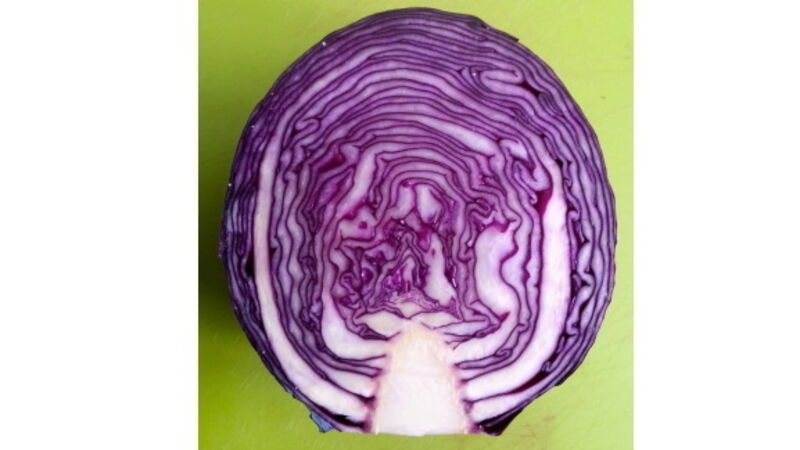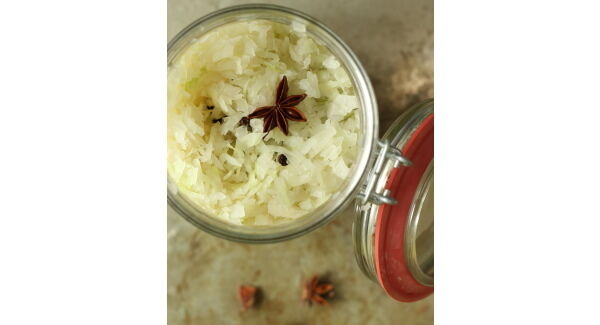Sweet on Sauer - the benefits of fermented foods

AT Val’s Kitchen HQ it’s all go for fermentation season as we all want our digestive systems to work better so we will feel more energetic, sleep better and happier simply because we don’t feel like we’re carrying around the weekly shopping in our colons.
Speaking of colons, I’m still up to my neck in vegan January.
Something I expected to be hell is turning out well and I never feel the heaviness that comes after eating a big, meaty dinner.
My sinus headaches that I’d had for years are gone, too.
Filling up the freezer with home-made food is the best way to go, so I spent several hours in the kitchen this weekend making lots of stash like veggie sausages, veggie burgers, falafel, hummus, curry, tomato sauce, chocolate truffles and brownies.
So now we’re in business for the week.
Fermented foods play an important part when it comes to being stocked up with vibrant, living foods for when you really don’t have time to cook, plus they add that important probiotic boost to your meals.
Sauerkraut is one of the fermented staples I keep on the kitchen counter, along with kimchi and kombucha.
Sauerkraut

There are many ways to make this but this is my favourite. You can shred your cabbage with a food processor or with a really sharp knife which I prefer as then I don’t have to clean the machine.
When making fermented foods, spend the extra pennies and buy organic. Non-organic will work too but it defeats the purpose of getting all those enzymes working if you have them all taken out with chemicals in the first place.
Equipment needed: 1 x 1litre mason jar, 1 instrument for ‘pounding’ the cabbage like a flat ended rolling pin, a very clean, large plastic basin or bowl, a small jar or stone for weighing the cabbage down in the jar, this will also have to be sterilised.
Makes one 1litre jar
1 head organic cabbage, red or white 1 tsp sea salt 1 tsp caraway seeds or other flavourings like star anise or black peppercorns
1. Shred the cabbage, leaving out the middle part.
2. Put the cabbage into the bowl with the salt and whey, if using, mix everything together with your hands and then get your rolling pin and begin pounding the cabbage, keep going for 10 minutes until some of the juices are being released, just think of the toned arms your getting! Sprinkle on the caraway seeds or other flavourings, or leave it plain.
3. Get your sterile jar and pack the cabbage in with the juices, press in down and pop in a jar, with weight or stone that’s big enough to put pressure on the cabbage when you close the lid down. You want it to be submerged in the juices. Place the jar on a plate to catch any juices that overflow.
4. Leave the jar at room temperature for four days, you should see bubbles happening in the jar, this means it’s working. In a cold winter maybe put it in the airing cupboard. Open the jar every day to release the gasses. You can refrigerate the sauerkraut after this time, this will stop the fermentation process, you can also let go of the weight in the jar.
Fire Water
Also called the master tonic, this ancient remedy is credited with healing everything but the plague, and when you see what’s in it, it’s easy to understand why.
Using apple cider vinegar, which we now know as a miracle anti-inflammatory ingredients, as a base and lots of powerful members of the allium family, this potent remedy will shake you up and help keep colds and flus at bay. If you do get struck by a nasty cold or flu, take a tablespoon 4-6 times per day and rest, rest, rest.
You will need a clean jar.
Ingredients 1 litre apple cider vinegar or kombucha which has turned to vinegar is good too
1 6-8 inch piece horseradish, grated
1 large white onion, peeled and chopped
1x 3 inch piece of fresh ginger root, grated
3-4 red chillies, chopped roughly
1 whole bulb of garlic with the cloves peeled and chopped
1. In a bowl mix all the vegetables together
2. Pack them into your clean jar 3. Pour over the vinegar until the liquid reaches the shoulder of the jar.
4. Close the lid and invert the jar back and forth a few times to make sure everything is well combined.
5. Shake at least twice a day for two weeks.
6. Strain the mixture through muslin, squeezing it to get as much liquid out as possible.
7. This never goes off and keeps at room temperature but keep it in the fridge if you prefer.
* For more fermented food check out the cookbook Val’s Kitchen, O’Brien Press, €19.99




